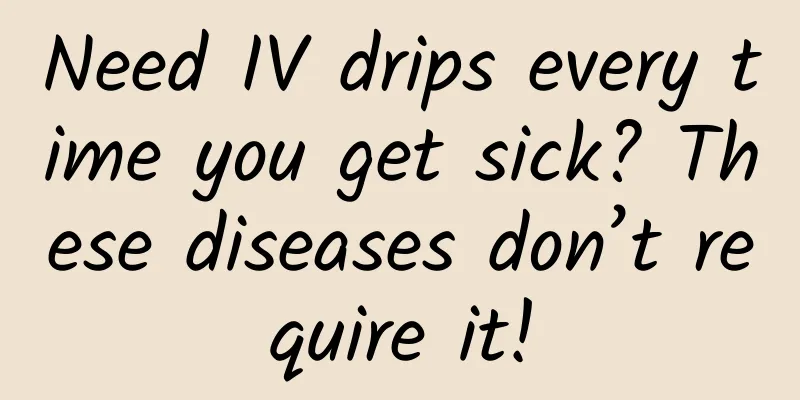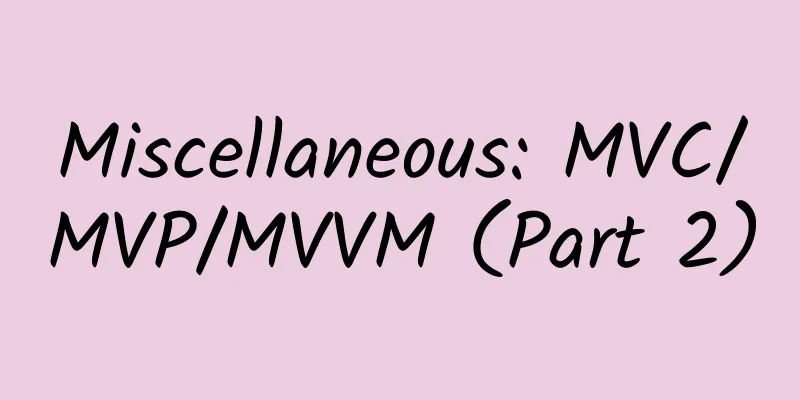Need IV drips every time you get sick? These diseases don’t require it!

|
For a long time, people have believed that intravenous infusion is more convenient and more effective than oral medication. However, they do not know that this is an extremely wrong treatment method and has many harmful effects on the body. Recently, the Hangzhou Health Commission issued a reminder: It is not recommended to have intravenous infusion as soon as you are sick. What is intravenous fluids? Is it better than oral administration? There are three main ways for people to use drugs: oral, intramuscular, and intravenous. What we often call infusion belongs to intravenous injection. Intravenous infusion refers to the administration of fluids or injectable drugs through the veins of patients to improve microcirculation, prevent and correct electrolyte disorders, and achieve the purpose of treating the patient's disease. It is usually a method of administration when the patient cannot be effectively treated by oral or intramuscular or subcutaneous injection of drugs. Because the drug enters the systemic circulation directly, intravenous infusion has a higher utilization rate or a faster onset of action compared to other routes of administration, such as oral, sublingual, rectal enema, subcutaneous or intramuscular injection, and nebulization inhalation. Image source: pixabay However, it is precisely because it directly enters the blood circulation, skipping the drug absorption process and eliminating the immune link of the human body to identify foreign substances, which makes it easier to cause adverse drug events. It is also because of the rapid onset of action that many people receive intravenous infusions when they are slightly sick, and even when they are not sick, they receive intravenous infusions to "replenish their body." The harm caused by abuse of intravenous infusion is serious and long-term. In addition to life-threatening drug allergic reactions, common infusion reactions include pyrogenic reactions, phlebitis, air embolism, particle embolism, leakage injury, acute heart failure, infection, etc. Infusing when you are sick is tantamount to chronic suicide. In addition, excessive intravenous infusion also increases the waste of medical resources and increases the financial burden on patients. Attention! These 53 diseases do not require intravenous infusion As an important medical reform measure, many places have controlled or cancelled intravenous infusion treatment for adults in hospitals. Some conditions, such as viral colds, chickenpox, bacterial upper respiratory tract infections, mild diarrhea, etc., do not require intravenous infusion. Oral administration of corresponding therapeutic drugs can cure the disease, which is safe and effective. The following 53 diseases do not require intravenous infusion treatment. Long-term regular oral medication is recommended for chronic diseases of internal medicine 1. Upper respiratory tract infection: common cold, viral pharyngitis 2. Acute tracheobronchitis, body temperature below 38°C 3. Patients with bronchiectasis without acute inflammation 4. Bronchial asthma is in the chronic persistent stage and remission stage 5. Pulmonary tuberculosis (except disseminated pulmonary tuberculosis) 6. Interstitial lung disease without obvious respiratory distress 7. COPD remission 8. Uncomplicated chickenpox, mumps, rubella 9. Hypertensive urgency 10. Chronic superficial gastritis 11. Non-infectious diarrhea with anhydration and electrolyte imbalance 12. Simple Helicobacter pylori infection 13. Mild colitis 14. Uncomplicated peptic ulcer 15. Mild liver damage with clear etiology 16. No organic lesions were found after multiple visits to the doctor, so functional gastrointestinal disease was considered 17. Acute cystitis 18. Spontaneous pneumothorax without complications 19. Simple premature ejaculation and ventricular premature ejaculation 20. Endocrine and metabolic diseases without acute complications 21. Alzheimer's disease without special complications, hemifacial spasm, motor neuron disease, multiple tics, sleep disorders, anxiety, depression, migraine 22. Epilepsy (except status epilepticus and frequent epileptic seizures) 23. Primary and secondary prevention of cerebrovascular diseases without special complications (non-acute stage of cerebrovascular diseases) 24. Renal anemia, nephrotic syndrome, chronic glomerulonephritis, proteinuria without special complications Surgery can be easily treated without intravenous injection 1. After resection of superficial tumor 2. Mild surface infection (no fever, normal blood count) 3. Mild soft tissue contusion 4. After minor body surface debridement 5. Superficial phlebitis 6. Senile osteoarthritis 7. Non-acute lumbar disc herniation and spinal stenosis 8. Closed non-surgical treatment of limb fractures 9. Chronic strain-related diseases 10. Chronic cystitis 11. Chronic prostatitis 12. Prostatic hyperplasia 13. Kidney stones without complications 14. Seminal vesiculitis 15. Acute rhinitis, various types of chronic rhinosinusitis, allergic rhinitis, acute sinusitis without complications 16. Acute simple pharyngitis, chronic pharyngitis, acute simple tonsillitis 17. Acute laryngitis (except severe cases) and chronic laryngitis 18. Acute and chronic external otitis, acute and chronic otitis media without complications, external auditory canal eczema, myringitis Pediatrics decides whether to give intravenous fluids based on the patient's condition 1. Upper respiratory tract infection: course of disease within 3 days, body temperature below 38°C, and good mental state. 2. Diarrhea in children: Those with mild dehydration can take oral rehydration. 3. Bronchiolitis: mild wheezing. 4. Hand, foot and mouth disease or herpetic pharyngitis: no fever, good mental state, and normal blood count. Gynecological antibiotics may destroy the "microecological environment" 1. Chronic pelvic inflammatory disease 2. Chronic cervicitis 3. Asymptomatic uterine fibroids 4. Bartholin's gland cyst 5. Vaginitis and vulvitis 6. Primary dysmenorrhea 7. Not associated with anemia and irregular menstruation Standardize infusion and use medication safely. Oral administration instead of intramuscular injection is recommended, and intramuscular injection instead of infusion is recommended. If you are feeling unwell, please follow the doctor's instructions on whether to receive an infusion. Planning and production Source: People's Daily Online Science and Technology Comprehensive Hangzhou Daily, Healthy Hangzhou Editor: Yang Yaping |
Recommend
When operating Douyin, you must avoid 3 types of data traps
With the increasing popularity of short videos, m...
From 0 to 1, interpreting Android ASO optimization!
Hello everyone, I am an ASO operations specialist...
There are always inexplicable bruises on my body. What kind of inexplicable physical phenomenon is this?
Review expert: Zhang Yuhong, chief physician of t...
Tik Tok game marketing example: downloads increased 40 times on iOS and 16 times on Android
Now more and more companies are paying attention ...
Visual Data Analyst Tutorial from Scratch
Introduction to the tutorial resources for learni...
Keep brand marketing promotion model!
In recent years, I have found that vertical Inter...
Nissan China: Dongfeng Nissan's cumulative sales from January to July 2022 were 535,280 vehicles
Among Japanese luxury brands, apart from Toyota&#...
Android 12 is here! Check out the Android 12 preview for hands-on experience
Recently, Google suddenly released the Android 12...
How much does it cost to join Ningbo’s flash sale mini program? Ningbo Seckill Mini Program Franchise Price Inquiry
How much does it cost to join a flash sale mini p...
Can the transformation into a "living room computer" be a lifeline for OTT boxes?
After the State Administration of Radio, Film and...
I want to travel - the seeds are crazy
When you were a kid, did you also dream about tra...
APM from entry to abandonment: Analysis of availability monitoring system and optimization methods
[51CTO.com original article] In the movie "T...
More than 30% of domestic mobile phone manufacturers died within one year
Behind the brilliant performance of domestic mobi...
JD.com: College students need to play hard when starting a business
Under the background of the country vigorously adv...
What’s so special about a football player’s dining table?
As the World Cup begins, more and more reports ar...









